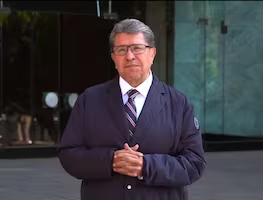Más Información

Violencia en el país evidencía colapso de estrategia de seguridad: PRI; insiste en cambiar el rumbo de combate

Defensa toma protesta al general Maximiliano Cruz Ramos; fungirá como Inspector y Contralor General de División de Estado Mayor

Sheinbaum destaca reducción de homicidios dolosos en último mes de 2024; “Confiamos en nuestra estrategia”, dice

Sheinbaum no hablará de seguridad en reunión con presidentes municipales; revisarán tema de infraestructura

Monreal reitera apoyo a Sheinbaum para este 2025; “la conducción del país está en buenas manos”, dice

Sheinbaum: Tenemos un plan bien elaborado para defender a los mexicanos; “ya lo vamos a presentar”, dice
The arrival of North American tourists in Mexico has reported it’s biggest drop in the last seven years due to travel warnings issued by the United States Government , as well as the overall insecurity in the Mexican territory.
The Migration Politics Unit from Mexico’s Ministry of the Interior (SEGOB) reported an air travel reception of 845,000 tourists from the United States on the past April , which represented a 6.8% decrease (61,000 people) with regard to the same month last year, when the institution reported the arrival of 906,000 tourists from the USA.
This is the first drop since October 2014 , as well as the most pronounced decline since July 2011 .
In this regard, Francisco Madrid, the director of the Faculty of Tourism and Gastronomy at the Anáhuac University , stated that the drop in tourists coming from the USA was due to several factors, including the seasonal effect of Easter celebrations , which occurred in March and not April , as was the case in 2017. However, the expert observed a downturn pattern in the first quarter, related to the effect of travel warnings issued by the Trump administration.
On August 22, 2017 , the US State Department issued an alert to all its citizens, warning them about safety conditions in the Mexican states of Quintana Roo, Baja California Sur, Baja California, Guerrero, Veracruz, Chiapas, and Colima .
However, on January 10 of the present year, the same authority released an update of the document, substituting the warnings with a much simpler system of recommendations, which suggests “taking extra precautions” when visiting Mexico, and avoiding the states of Sinaloa, Michoacán, Guerrero, Colima, and Tamaulipas .
Upon knowing about the modification, the Ministry of Tourism (SECTUR) declared that Cancún, Rivera Maya, Los Cabos, Puerto Vallarta, Riviera Nayarit, and Mexico City , which represent 80% of tourist attractions in the country, were exempt of the restrictions issued by the US State Department .
According to Madrid, the depreciation of the Mexican peso could serve as a stimulus to draw more visits. However, it has become clear that this trend hasn’t generated significant results.
The US dollar reached a cost of over 20 pesos on the second half of the month of May , reaching prices up to 21.15 pesos in CitiBanamex’s exchange windows on June 14 .
“ One of the causes is insecurity ,” stated Armando Bojórquez , director of the Bojórquez Travels franchise network , who believes that the drop in US tourists coming to Mexico is distressing. He doubts that the Holy Week effect has had an influence in the yearly comparison, since North American tourists don’t usually travel during that vacation period.

The businessman expressed that the US Government’s travel warnings, as well as news about drug violence in Mexico and Donald Trump ’s statements are probably the main causes of April’s tourism drop.
Historically, the United States has been Mexico’s main source of tourism income, with six out of ten tourists coming from the country up north, while Canada is second place.
To avoid an excessive financial dependence, the head of the Ministry of Tourism, Enrique de la Madrid , has set a goal to promote Mexico in Latin American, European, and Asian markets so that travelers from North America represent no more than half of tourists coming to Mexico in the future.
For a few years now, tourists coming from other countries have shown a considerable growth rate. For example, the entry of Argentinians grew 23.3% in the month of April , and they are now competing for third place , along with the British market .
The entry of Peruvians grew 32.3% ; Brazilians, 14.5% , and Colombians, 4.1% , which has overgrown the entry of Spanions, Italians, and Germans , according to SEGOB .
“The fact that tourism is diversifying is encouraging, but we shouldn’t let down our guard; most of this is due to the fact that the US market is weakening, and the consolidation of other markets has little to do with it,” Madrid concluded.
Bojórquez predicts an increase in the number of tourists coming from Latin America in the following years, mainly from Bolivia , due to the annulment of the Mexican visa .
“ We’re becoming an attractive option for Latin Americans , given their difficulty in obtaining US visas,” said Bojórquez, who is also chairman of the Confederation of Latin American Tourist Organizations (COTAL) .
“We welcome Latin Americans. They are far better tourists than those from the US, anyway. Unlike them, they actually go out shopping instead of shutting in at their hotels,”
the businessman added.
dm



